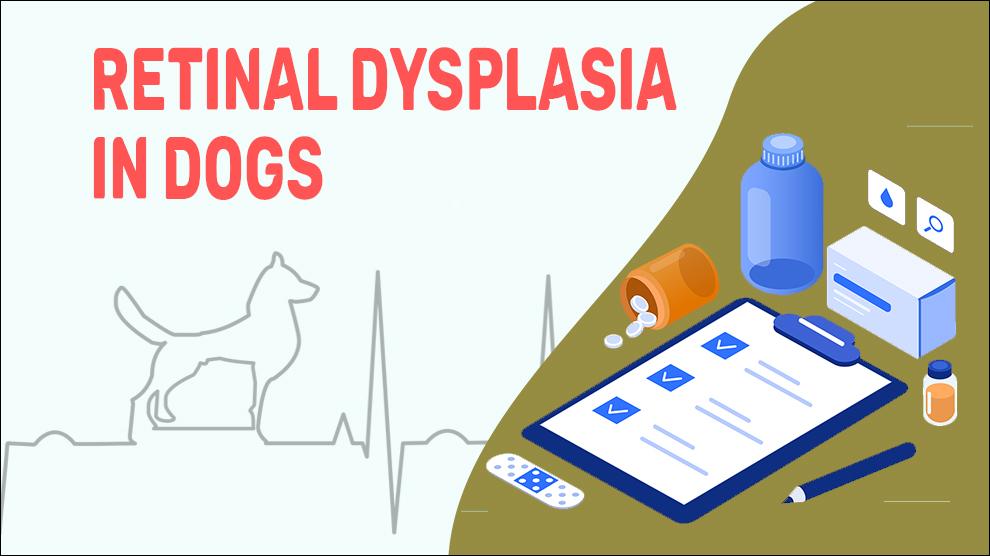What Is Retinal Dysplasia In Dogs?
Retinal dysplasia is an autosomal, inherited, bilateral, non-progressive, retinal malformation due to tubular rosettes and linear folds within the sensory retina.
Retinal dysplasia (RD) is a disorganized differentiation of retinal tissues, characterized histologically by the sensory retina’s linear folding and rosette formation containing inconsistent numbers of neuronal retinal cells around a central lumen.
The severity of the retinal dysplasia varies from simple linear lesions (folds) to larger geographic lesions that may be accompanied by pigmentary changes and localized retinal degeneration, or, sometimes vitreoretinal dysplasia with total retinal non-attachment (in its most severe form).
There are many theories for idiopathic retinal dysplasia. The neural retina’s hyperplasic extension into abnormal sites away from the pigmented epithelium is the most common theory.
In the developmental stage, the neural retina’s Secondary detachment from the retinal pigment epithelium (RPE) is another theory. RD is said to occur in areas without pigment epithelium. Also, decreased levels of mitochondrial and nuclear transcripts in the retina and RPE indicate reduced energy contribution to the retina and RPE.
Symptoms Of Retinal Dysplasia In Dogs
- Bumping into objects
- Reluctance to jump down from chairs
- Eyes cloudy look/grey color with a slight sheen
- Night blindness/Day blindness
- Dilated pupils
- Difficulty seeing in bright light
- Color changes within the eye
- Unable to follow hand signals/commands
- Behavioral changes
Treatment Options For Retinal Dysplasia In Dogs
There is no proper treatment protocol for Retinal dysplasia
- Antioxidant treatment: Delay the rate of the retinal deterioration
- Oral and/or Systemic Antibiotics
- Supportive therapy
- Early stages of the disease; carotenoid supplement Lutein
- Antibiotic ointments and/or Lubricant ointments
Home Remedies For Retinal Dysplasia In Dogs
- Using baby shampoo clean the eyelids and/or applying warm compresses will be soothing to the eyes
- Chamomile tea cold compress: It has anti-inflammatory properties and it will be refreshing to sore or red eyes
How To Prevent Retinal Dysplasia In Dogs?
There is no way of preventing retinal dysplasia.
Prevention of Retinal dysplasia is a hereditary concern. Genetic screening is not available; however, it is better not to breed affected dogs.
Pet owners should be aware of risk factors associated with RD. Keep yourself updated about the symptoms and availability of medications.
Affected Dog Breeds Of Retinal Dysplasia
American Cocker Spaniel, English Springer Spaniel, Beagle, Labrador Retriever, Miniature Schnauzer, Australian Shepherd, Rottweiler, Bedlington Terrier, Sealyham Terrier, Yorkshire Terrier
Causes And Types For Retinal Dysplasia In Dogs
1. Causes:
- Retinal dysplasia is a hereditary condition due to an autosomal recessive gene carried by any of the parent dogs
- Infectious causes: Canine adenovirus, Canine herpesvirus, and Canine parvovirus
- Dietary causes: vitamin A deficiency
- Intrauterine trauma
- Toxins
2. Types:
Focal or multifocal retinal dysplasia:
- Rosettes and retinal folds are seen as areas of decreased tapetal reflectivity
- Tapetal area: round or linear, dark-gray hyperreflective streaks as gray or white streaks. The central fundus, in the tapetal area, is the most common location
- Non-tapetal area: as white-gray, linear vermiform, or round lesions
- Vision is usually unaffected
- This form is seen in beagles, Labrador retrievers, rottweilers, and spaniels
Geographic retinal dysplasia:
- U-shaped or Irregular regions are seen in the tapetal fundus
- Occurrence of thinned and elevated parts of the retina, with black or gray areas demarcating the affected retina
- hyperreflectivity areas may also be present
- Areas of increasing pigmentation may indicate Retinal pigment epithelial hypertrophy
- Depending on the size of the lesion, Vision may be severely affected
- This is prevalent amongst Labrador retrievers and spaniels
Complete retinal dysplasia with detachment:
- Totally disconnected neural retina connected to the optic nerve head is present
- Vitreous dysplasia hemorrhages rotatory nystagmus and leukocoria may be seen in affected animals
- Severe visual impairment/blindness is usual
- This form is seen in Bedlington, English springer spaniels, and Sealyham terriers
- Also, Samoyeds and Labrador retrievers (when combined with skeletal chondrodysplasia)
3. Mortality:
There is no documented mortality due to this condition.
4. Diagnosis:
- Complete blood count (CBC)
- Biochemical profile
- Ocular ultrasound
- ERG or Electroretinogram to check the dog’s vision
- Tonometry, slit lamp, and fundoscopy
- Inner eye gonioscopy
5. Prognosis:
The prognosis for dogs diagnosed with retinal dysplasia is poor as it is a hereditary condition. Most dogs enjoy a pain-free life with careful attention and monitoring.
When To See A Vet For Retinal Dysplasia In Dogs?
Contact your vet right away, if you notice any of the following:
- Dilated pupils
- Eyes cloudy look/grey color with a slight sheen
- Night blindness/Day blindness
Food Suggestions For Retinal Dysplasia In Dogs
- Sea foods such as Whitefish, Flounder, salmon, Herring, Anchovies, walleye, herring, etc
- Plant/ Non-meat protein sources such as Eggs, chickpeas, green peas, Lentils, soybeans
- Leafy greens such as lettuce, spinach, kale, cabbage, etc
- Omega-3 oily fishes: Sardines, salmon, cod, tuna, etc
- Carotenoid foods: sweet potatoes, carrots, Egg yolks, pumpkin, kale, spinach
- Antioxidants such as Broccoli, cabbage, carrots, and Blueberries
- Zinc foods such as Lamb, Pork, Salmon, Oysters
Conclusion
Prognosis for return of vision is poor to guarded. The dogs will settle in and they will balance for their deficient vision by developing a strong sense of smell and hearing to help them getting around. Eye medications have to be administered according to the vet’s instructions.

















